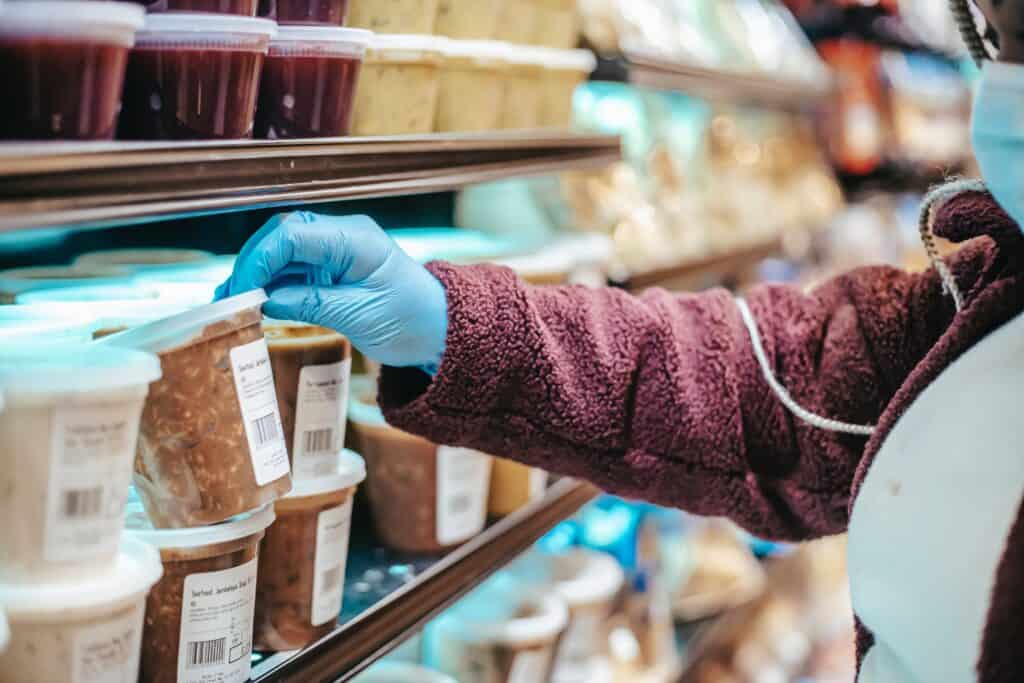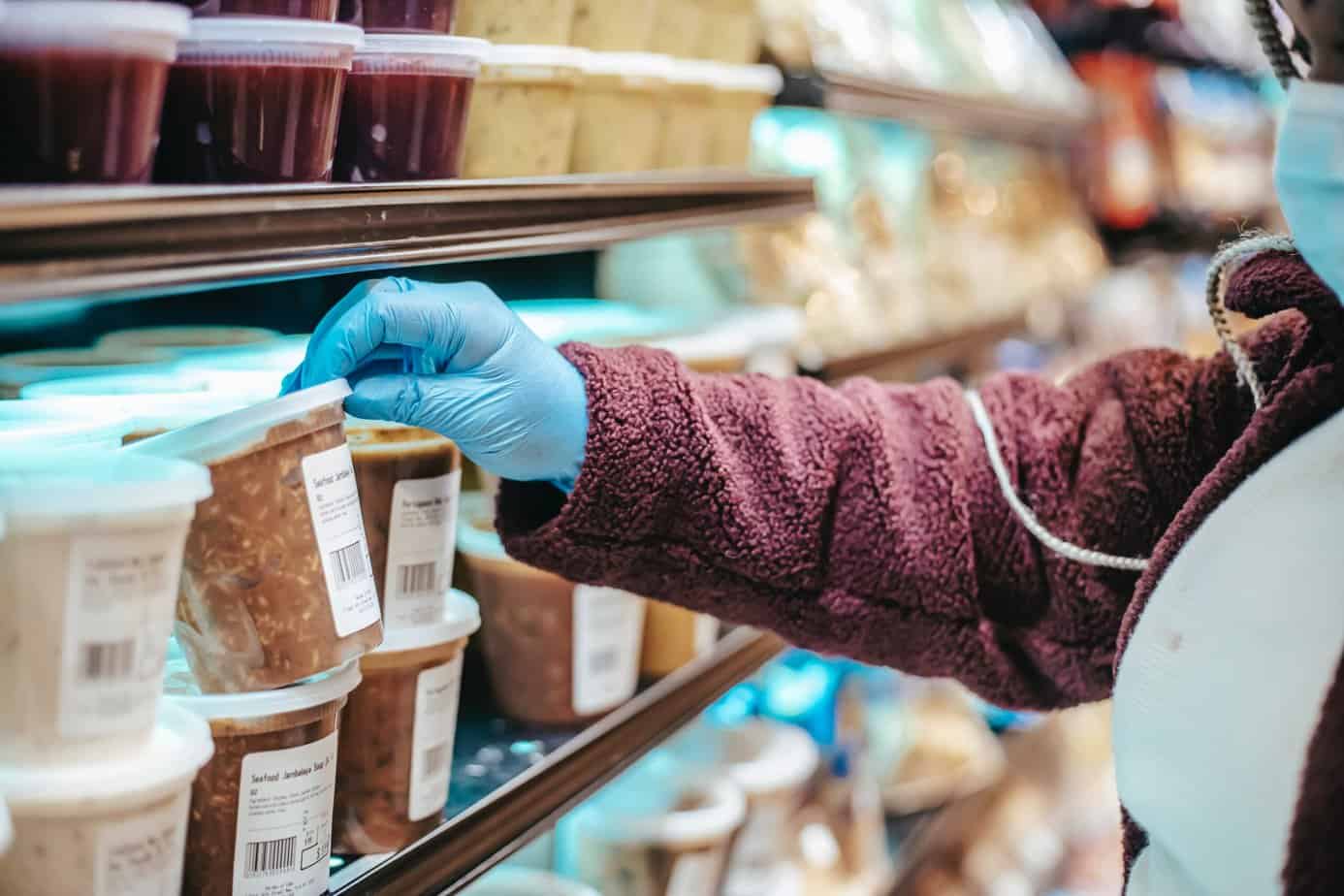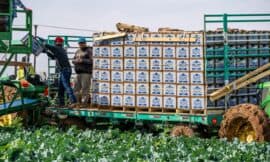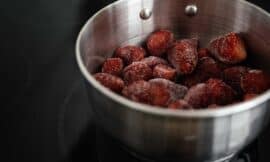Handling frozen food is an essential skill. Freezing is a convenient way to preserve food and extend its shelf life. However, it’s important to handle frozen food properly to prevent foodborne illnesses and ensure that the food retains its quality and flavor.
Understanding Frozen Foods is the first step in handling them properly. Freezing slows down the movement of molecules, causing microbes to enter a dormant stage. This preserves the food for extended periods because it prevents the growth of microorganisms that cause both food spoilage and foodborne illness. It’s important to note that freezing doesn’t destroy bacteria and parasites, but it does keep them from growing. Therefore, it’s crucial to select and prepare food for freezing carefully, store it properly, and thaw and cook it safely.

Key Takeaways
- Handling frozen food is crucial to prevent foodborne illnesses and ensure that the food retains its quality and flavor.
- Freezing preserves food by slowing down the movement of molecules, causing microbes to enter a dormant stage.
- It’s important to select and prepare food for freezing carefully, store it properly, and thaw and cook it safely.
Understanding Frozen Foods
Defining Frozen Foods
Frozen foods are those that have been subjected to a freezing process to preserve their quality, texture, and flavor. The freezing process involves lowering the temperature of the food to a point where all the water in the food turns to ice. This process helps to slow down the growth of microorganisms that cause food spoilage and foodborne illness.
Benefits of Freezing Food
Freezing food is an excellent way to preserve its quality and extend its shelf life. When frozen correctly, food can last for months or even years without losing its nutritional value or flavor. Additionally, freezing food can help to reduce food waste by allowing you to store excess food for future use.
Common Frozen Food Types
There are many types of foods that can be frozen, including vegetables, fruits, meats, seafood, and dairy products. Some common frozen food types include:
- Frozen vegetables: These are vegetables that have been blanched and frozen to preserve their texture and nutritional value.
- Frozen fruits: These are fruits that have been frozen to preserve their flavor and nutritional value.
- Frozen meats: These are meats that have been frozen to preserve their quality and flavor. Meats should be frozen as soon as possible after purchase to ensure maximum freshness.
- Frozen seafood: These are seafood products that have been frozen to preserve their texture and flavor. Seafood should be thawed slowly in the refrigerator to prevent the growth of harmful bacteria.
- Frozen dairy products: These are dairy products that have been frozen to preserve their texture and flavor. Some common frozen dairy products include ice cream, frozen yogurt, and frozen custard.
Overall, freezing food is an excellent way to preserve its quality and extend its shelf life. By understanding the freezing process and the different types of frozen foods available, you can make informed decisions about how to best store and use frozen foods in your home.
Tips for Handling Frozen Food
Handling frozen food effectively involves several best practices to maintain food quality and safety. Here are 7 tips to handle frozen food:
- Thaw safely in the refrigerator, under cold water, or in the microwave, not at room temperature.
- Freeze in portions for easy thawing.
- Use airtight packaging to prevent freezer burn.
- Label and date packages to track storage times.
- Keep the freezer at the right temperature (0°F or below).
- Refreeze only if ice crystals are present or if thawed in the refrigerator.
- Cook without thawing when possible for convenience.
Here are some best ways to thaw frozen foods.
Handling various Frozen foods
Here is a table on various frozen food type and how to handle them:
| Frozen Food Type | Thawing Method | Cooking Recommendation | Storage Tip |
|---|---|---|---|
| Meats (beef, chicken) | Refrigerator or cold water | Cook immediately after thawing if microwaved | Use within 3-4 days after thawing in the refrigerator |
| Fish & Seafood | Refrigerator or cold water | Can be cooked without thawing for some recipes | Use within 1-2 days after thawing |
| Vegetables | Not necessary to thaw | Cook directly from frozen to retain texture | Store in air-tight bags to prevent freezer burn |
| Breads & Pastries | At room temperature or in the refrigerator | Reheat in oven or toaster for best results | Wrap tightly to avoid air exposure |
| Prepared Meals | Microwave or oven based on packaging instructions | Follow specific package cooking instructions | Ensure proper sealing before freezing |
Freezing and Storing Food Safely
When it comes to preserving food, freezing is a popular and effective method. However, proper techniques must be followed to ensure food safety and prevent freezer burn.
Proper Freezing Techniques
Before freezing food, it is important to ensure it is fresh and of good quality. Label the food with the date of freezing to keep track of its age. Proper packaging is essential to prevent freezer burn. Use freezer-safe containers or bags, and remove as much air as possible to prevent ice crystals from forming.
Freezer Management
Maintaining the proper temperature in the freezer is crucial for food safety. The freezer should be set at 0°F (-18°C) or lower. It is important to keep the freezer door closed as much as possible to maintain the temperature. A food thermometer can be used to ensure the temperature is within the safe range.
Preventing Freezer Burn
Freezer burn occurs when food is improperly packaged and exposed to air. It causes dry, discolored spots on the surface of the food and can affect the taste and texture. To prevent freezer burn, use freezer-safe containers or bags and remove as much air as possible before freezing. It is also important to use the food within the recommended storage time to ensure the best quality.
By following proper freezing techniques, managing the freezer temperature, and preventing freezer burn, we can safely preserve food for later use.
Selecting and Preparing Food for Freezing
When it comes to freezing food, selecting the right foods, preparing them correctly, and packaging and labeling them appropriately are all important steps to ensure the safety and quality of your frozen goods. In this section, we’ll cover the key considerations for each of these steps.
Choosing the Right Foods
Not all foods are suitable for freezing. Some foods, such as lettuce, cucumbers, and watermelon, have a high water content and can become mushy or watery when frozen. Other foods, such as mayonnaise and cream sauces, can separate and become grainy when frozen. When selecting foods to freeze, it’s important to choose foods that will freeze well and maintain their quality.
For meats, poultry, and fish, it’s important to choose fresh, high-quality products. Look for cuts that are firm and have a bright color. For vegetables and fruits, choose produce that is ripe but not overripe. Overripe produce can become mushy when frozen.
Preparation Methods
Proper preparation is key to ensuring the safety and quality of your frozen foods. Before freezing, it’s important to clean and sanitize your work area and all utensils and containers. Wash your hands thoroughly before handling food.
For meats, poultry, and fish, it’s important to trim off any excess fat and remove any bones. For vegetables and fruits, wash and peel as necessary.
Blanching is a common preparation method for many vegetables. Blanching involves briefly boiling the vegetables and then immediately plunging them into ice water to stop the cooking process. Blanching can help preserve the color, texture, and nutrient content of vegetables.
Packaging and Labeling
Proper packaging and labeling are important steps to ensure the safety and quality of your frozen foods. Use freezer-safe containers or bags that are designed for freezing. Be sure to leave some room at the top of the container or bag to allow for expansion as the food freezes.
Label each container or bag with the name of the food, the date it was frozen, and any other relevant information, such as cooking instructions or expiration dates.
In summary, selecting the right foods, preparing them correctly, and packaging and labeling them appropriately are all important steps to ensure the safety and quality of your frozen foods. By following these guidelines, we can confidently freeze a variety of meats, poultry, fish, vegetables, fruits, and dairy products for later use.
Thawing and Cooking Frozen Food
When it comes to handling frozen food, thawing and cooking are two essential steps that must be done properly to avoid foodborne illness. In this section, we’ll discuss safe thawing techniques and cooking methods for frozen food.
Safe Thawing Techniques
Thawing frozen food properly is crucial to prevent bacterial growth. There are three safe ways to thaw frozen food: in the refrigerator, in cold water, and in the microwave. Thawing food in the refrigerator is the safest method, but it requires more time. It is recommended to plan ahead and allow enough time for the food to thaw in the refrigerator.
If you need to thaw food quickly, you can use the cold water method. Place the frozen food in a leak-proof plastic bag and submerge it in cold water. Change the water every 30 minutes until the food is thawed. Never use hot water to thaw frozen food, as it can promote bacterial growth.
Microwaving is another quick way to thaw frozen food, but it is important to follow the microwave instructions carefully to ensure that the food is evenly thawed. Be sure to cook the food immediately after thawing in the microwave.
Cooking Frozen Foods Directly
Some frozen foods can be cooked directly without thawing. For example, frozen vegetables can be cooked in boiling water or in the microwave without thawing. However, it is important to check the cooking instructions on the package to ensure that the food is cooked to the proper temperature.
Adjusting Cooking Times
When cooking frozen food, it is important to adjust the cooking time to account for the fact that the food is frozen. In general, frozen food will take longer to cook than fresh food. Always use a food thermometer to check the internal temperature of the food to ensure that it is cooked to a safe temperature.
When cooking meat and poultry products, it is important to cook them to the proper temperature to kill any harmful bacteria. For example, poultry products should be cooked to an internal temperature of 165°F (74°C) to ensure that they are safe to eat.
Handling frozen food requires proper thawing and cooking techniques to avoid foodborne illness. By following these guidelines, we can ensure that our food is safe and delicious.
Health and Safety Considerations
When it comes to handling frozen food, there are a few health and safety considerations that we must keep in mind. In this section, we will discuss some of the most important things to keep in mind when handling frozen food.
Avoiding Foodborne Illnesses
One of the most important things to keep in mind when handling frozen food is to avoid foodborne illnesses. Harmful bacteria can grow in food if it is not handled properly, which can lead to foodborne illnesses. To avoid this, it is important to keep high-risk foods, such as meat, poultry, and fish, at a safe temperature. The “danger zone” for food is between 40°F and 140°F, so it is important to keep food out of this temperature range as much as possible.
Maintaining Nutritional Value
Another important consideration when handling frozen food is maintaining its nutritional value. Freezing can cause some loss of nutrients, but it is still a great way to preserve food for long periods of time. To maintain the nutritional value of frozen food, it is important to handle it properly. For example, it is important to freeze food as soon as possible after it is cooked to prevent the growth of harmful microorganisms.
Handling High-Risk Foods
When handling high-risk foods, such as meat, poultry, and fish, it is important to take extra precautions to prevent contamination. For example, it is important to wash your hands thoroughly before and after handling these foods. It is also important to use separate cutting boards and utensils for these foods to prevent cross-contamination.
In conclusion, when handling frozen food, it is important to keep in mind the risk of foodborne illnesses, the importance of maintaining nutritional value, and the need to take extra precautions when handling high-risk foods. By following these guidelines, we can ensure that our frozen food is safe to eat and retains its nutritional value.
Refreezing Previously Frozen Food
When it comes to handling frozen food, refreezing is a common concern. Many people wonder if it is safe to refreeze previously frozen food. In this section, we will discuss when it is safe to refreeze, as well as the impact on quality and safety.
When Is Refreezing Safe?
According to the USDA, it is safe to refreeze previously frozen food if it has been handled properly. If the food was thawed in the refrigerator and not left out at room temperature for more than two hours, it can be refrozen. However, if the food was thawed at room temperature or in the microwave, it should not be refrozen.
It is important to note that refreezing can affect the quality and texture of the food. If the food has been thawed and refrozen multiple times, it may become dry and lose its flavor. Additionally, refreezing can impact the safety of the food.
Impact on Quality and Safety
Refreezing previously frozen food can have an impact on both the quality and safety of the food. As mentioned earlier, multiple cycles of thawing and refreezing can cause the food to lose its flavor and texture. This is because the moisture in the food can evaporate during the freezing and thawing process, leading to a dry and unappetizing product.
In terms of safety, refreezing can be risky if the food has not been handled properly. Bacteria can grow rapidly in food that has been left at room temperature for too long. Therefore, it is important to follow proper food safety guidelines when handling frozen food, especially when it comes to leftovers.
In conclusion, refreezing previously frozen food can be safe if it has been handled properly and has not been thawed multiple times. However, it is important to be aware of the impact on quality and safety, and to follow proper food safety guidelines to prevent contamination and potential illness.
Best Practices for Food Service Operations
At our food service operation, we take food safety seriously, especially when it comes to handling frozen foods. Here are some best practices we follow to ensure the safety of our customers and staff:
Managing Frozen Goods Inventory
Proper inventory management is crucial when it comes to handling frozen foods. We ensure that our frozen goods are stored at the correct temperature of -18°C / 0°F or below at all times. We also prioritize storing high-risk foods such as poultry, meat, seafood, eggs, and dairy products before less hazardous foods. This helps us minimize the risk of cross-contamination.
Training Food Handlers
Training our food handlers is an essential part of our food safety program. We ensure that all of our food handlers are trained in safe food handling practices, including proper handwashing, the use of cutting boards and utensils, and the importance of avoiding cross-contamination. We also train our staff on how to properly receive and handle frozen food deliveries to ensure that the food remains at the correct temperature throughout the delivery process.
Regulatory Compliance
We adhere to all regulatory requirements set by the FDA and other relevant authorities. This includes regularly calibrating our thermometers to ensure that they are accurate and using them to monitor the temperature of our frozen goods. We also ensure that our staff follows all food safety regulations, including proper handwashing and the use of gloves when handling food.
By following these best practices, we can ensure that our customers are safe from food poisoning and other foodborne illnesses. We take pride in our commitment to food safety, and we are confident that our practices are effective in ensuring the safety of our customers and staff.
Frequently Asked Questions
What are the USDA guidelines for the safe handling of frozen food?
The USDA provides guidelines for the safe handling of frozen food to prevent foodborne illnesses. These guidelines include properly packaging the food, labeling it with the date of freezing, and storing it at 0°F or below. Additionally, it is important to cook frozen food to the recommended temperature to ensure that any harmful bacteria are destroyed.
How does freezing affect the quality and safety of food products?
Freezing is an effective way to preserve the quality and safety of food products. However, freezing can also affect the texture and flavor of some foods. It is important to freeze foods at their peak freshness and quality to ensure the best taste and texture after thawing.
What are the recommended procedures for thawing frozen food safely?
It is recommended to thaw frozen food in the refrigerator, in cold water, or in the microwave. Thawing food at room temperature is not recommended. It is important to cook thawed food immediately to ensure its safety.
Can you provide examples of foods that freeze well and those that do not?
Foods that freeze well include fruits, vegetables, meat, poultry, fish, bread, and baked goods. Foods that do not freeze well include mayonnaise, cream sauces, lettuce, and some fruits and vegetables with high water content, such as watermelon and cucumbers.
What are the best practices for storing frozen foods to maintain their quality?
To maintain the quality of frozen foods, it is important to store them at 0°F or below. It is also important to use airtight packaging to prevent freezer burn and to label the food with the date of freezing. It is recommended to use frozen food within 6-12 months for the best quality.
What safe handling practices should be followed for frozen fruits and vegetables?
Frozen fruits and vegetables should be handled with the same care as fresh produce. It is important to wash hands before and after handling frozen fruits and vegetables, and to wash them thoroughly under running water before consuming. It is also important to cook frozen fruits and vegetables to the recommended temperature to ensure their safety.





